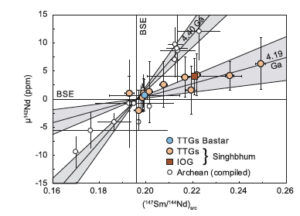Maltese, A. ; Caro, G. ; Pandey, O.P. ; Upadhyay, D. ; Mezger, K.
Communications Earth and Environment, 2022, 3, 12
`Voir en ligne : https://doi.org/10.1038/s43247-022-00341-9

Abstract :
Constraints on the evolution of the silicate Earth between 4.5 and 3.8 billion years ago are limited by the scarcity of pristine geological material from that period. The geodynamic evolution of the early Earth, prior to the preserved rock record, is thus mainly inferred from numerical modelling. To evaluate the geological significance of these simulations, geochronological constraints pertaining to the evolution of the Hadean crust are required. Here we show using Neodymium isotope variations generated by decay of now-extinct 146-Samarium that Paleoarchean rocks from the Singhbhum Craton, India derived from a Hadean depleted mantle reservoir that differentiated 4.19+0.06−0.12 billion years ago. The event postdates Neodymium model ages of mantle depletion inferred from other Archean rocks by 200 million years. This geochronological record is mirrored in the Hafnium isotope composition of the oldest zircon grains, suggesting that Hadean mantle differentiation proceeded via distinct pulses of large-scale magmatic activity and crustal rejuvenation.



